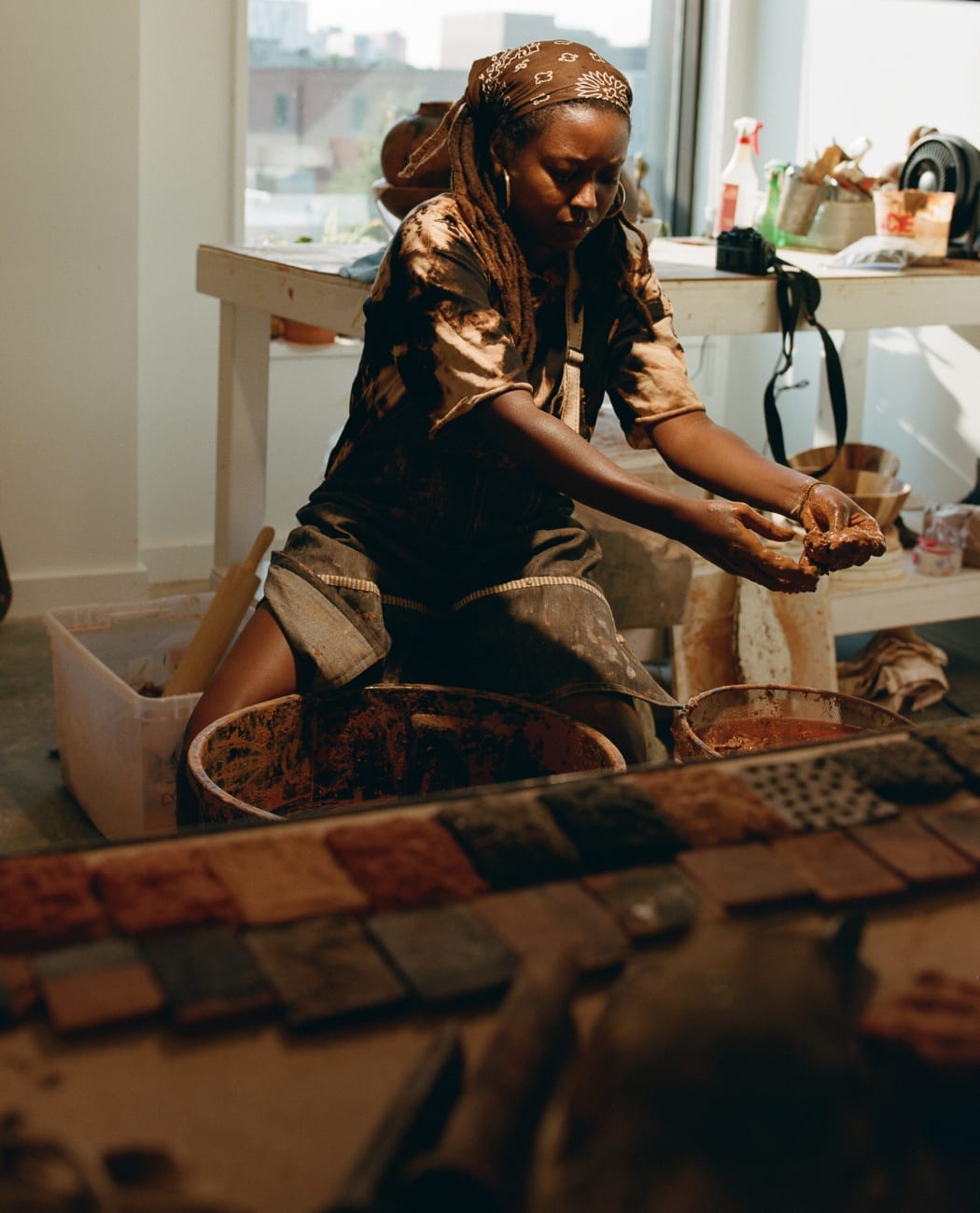
Dear Adebunmi, we always like to start our series at the very beginning of the artistic career and path. Could you tell me a bit about what stood at the beginning of your artistic career, and have you always felt an artistic drive and known you wanted to become an artist? Or was there a certain pivotal moment that made you realize that you would like to follow an artistic path?
I was raised by a single mother in New Jersey, here in America. My mom was friends with other single mothers who supported each other by raising their children together. Looking for ways to engage us creatively, at the age of three, my mom, along with her other friends with kids, had all of us join an art class at the Newark Museum in New Jersey. So, I've kind of always been engaged in art making. My mom would litter the hallways of our apartment with the works that I made in this museum class, and then at some point, when I was around eight or nine, she enrolled me in a private art class. There was a retired art teacher in our neighborhood who gave very intensive, pretty advanced art classes to children in her home studio. So, my educational art curriculum was supplemented with these private art classes, and at the end of what she would consider a semester, we would exhibit in the local gallery in the community. I have memories of being eight and exhibiting my painting of Simba from Lion King or sculptures of whatever I was sculpting at the time in these gallery shows. Once I got into high school, I had to start making decisions about what I would study in college. I was a really rebellious student and challenged my teachers and that didn't always go well, but the one class and the one thing that was clear that I was good at and could really excel in was art.
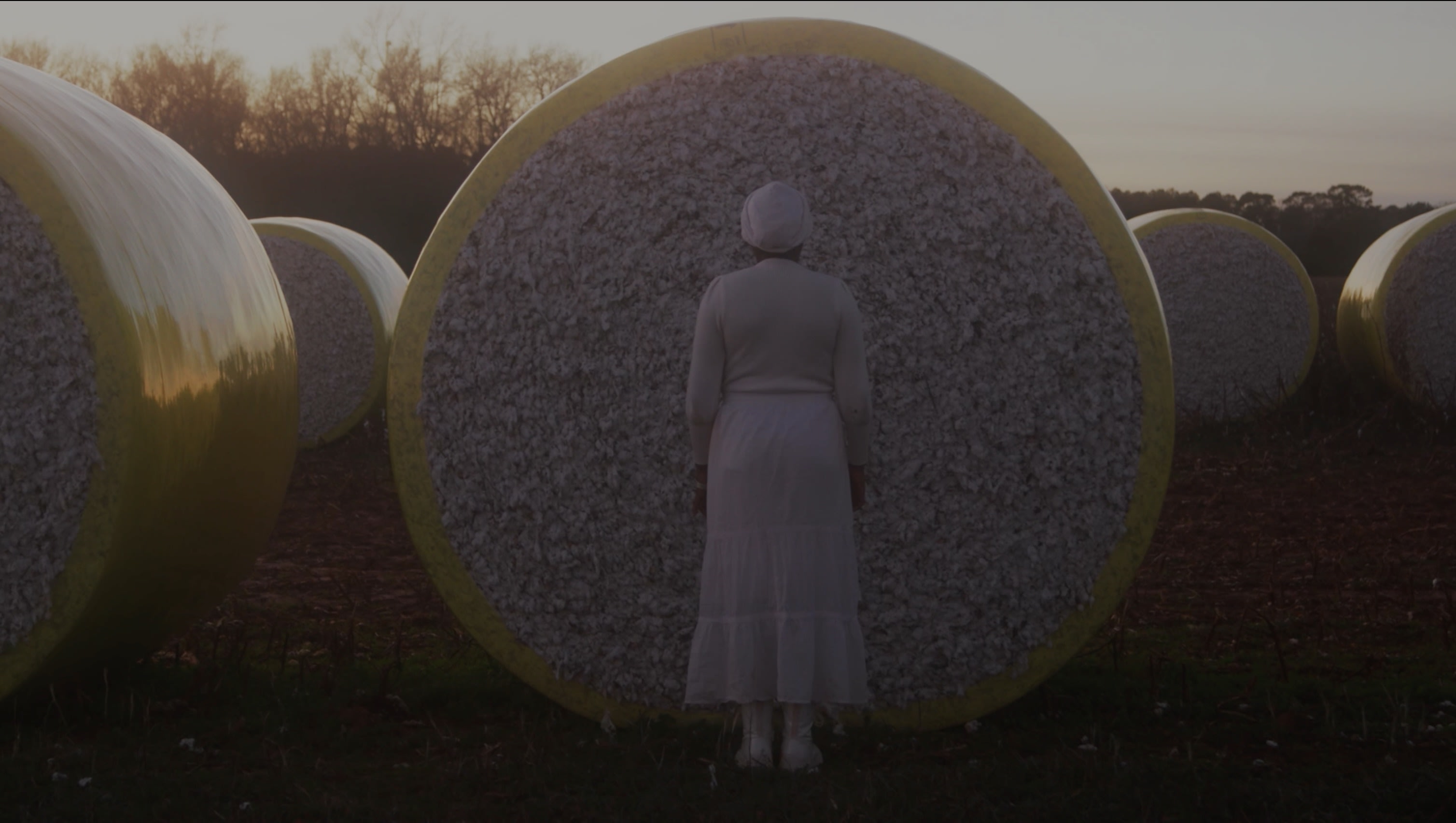
Image of Adebunmi Gbadebo onTrue Blue Plantation, standing in front of a cotton bail before it gets hauled off to the cotton gin. © Adebunmi Gbadebo
That sounds like an interesting childhood full of art, how lovely. Let’s move on to your practice nowadays: You explore archival records of your family's ancestry in Nigeria and enslavement in America. What do these records look like? And when did you first come across them?
It was when I learned that my mom's side knew the name and the exact location of the plantation where our ancestors were enslaved when they were brought to this country, which was True Blue Plantation in Fort Motte in South Carolina. A lot of Black Americans who do have a connection or history of enslavement can't necessarily identify or locate the exact location of that enslavement. That system thrived on the belief that we were not human. So, the ways in which we were documented throughout history often reflects that level of dehumanization, making it difficult to trace our history. The fact that we had the name of the plantation allowed me to really be very specific in my research. And what's interesting about True Blue Plantation specifically is that, even though I was looking at my maternal line a lot, through archives I also found that a lot of the Africans stolen to work on these particular plantations, which were rice and indigo, were specifically selected and stolen for their knowledge of the land. Europeans or these new colonizers of the Americas didn’t have a history of cultivating rice or indigo, those crops are not indigenous to Europe or North America, and they're very laborious and intricate to cultivate. So, Africans stolen from Sierra Leone, Nigeria, Guinea or Senegambia were specifically stolen for their knowledge, history, and culture with these crops. Understanding that context brought me back across the Atlantic and made me look at the traditions in those countries, and consequently, made me look at traditions in Nigeria, as I'm also half Nigerian. This ultimately linked my paternal and maternal lines of ancestry.
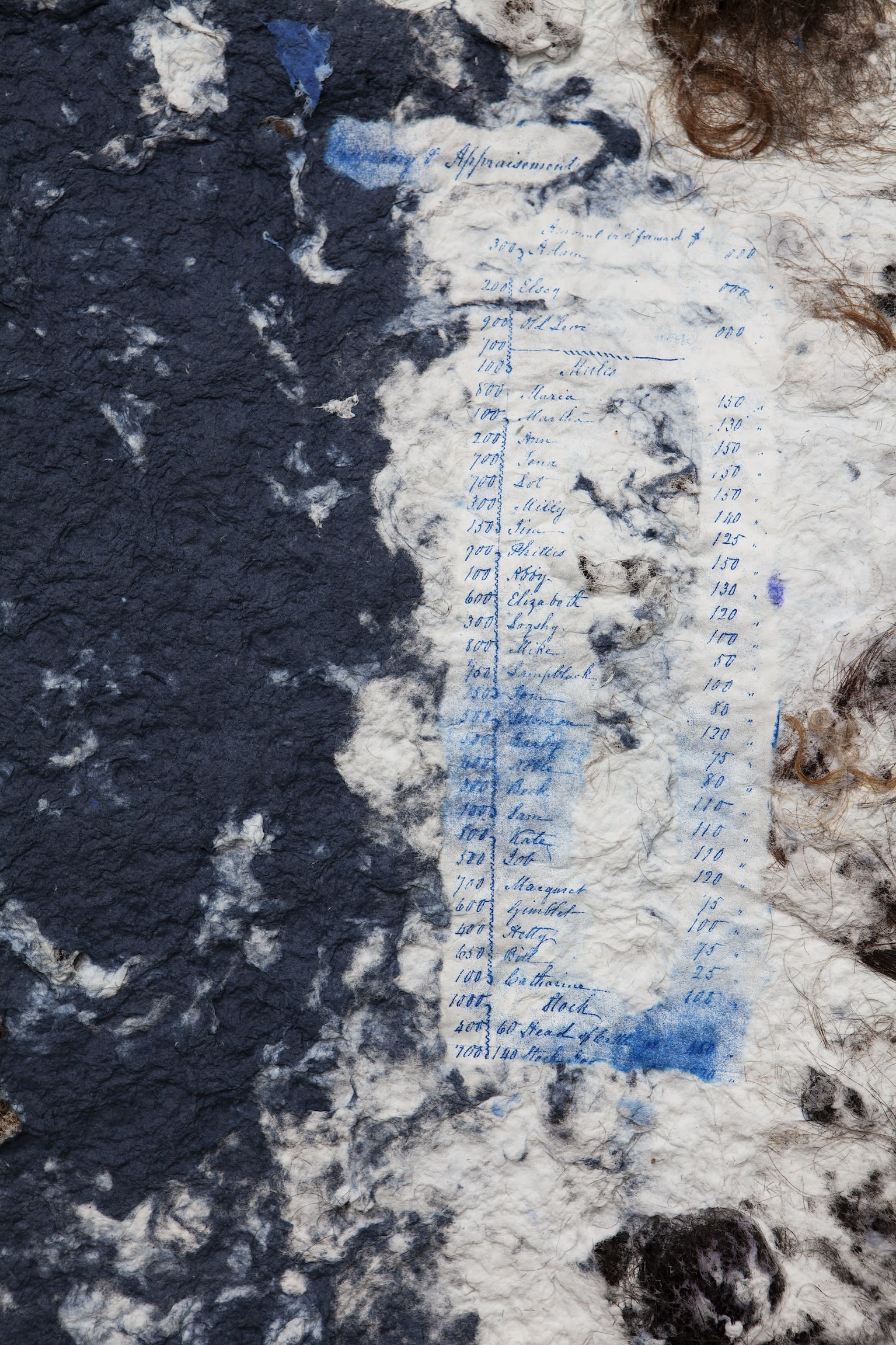
Detail shot of Adebunmi Gbadebo’s work 'Afro Paper'. The sheet has an appraisal list documenting humans and animals and their price. © Adebunmi Gbadebo
Which stories and discoveries in these records have had the deepest impact on you, both personally and artistically?
I remember the moment I found a will. It listed 185 enslaved people by name, age and the role that they had to do on the plantation. This exact same will also listed the alcohol that the enslaver was passing down, or the guns. To see human beings listed as something to pass down alongside objects and alcohol, I remember feeling enraged. But I also remember feeling elated that, in this history, where we are primarily anonymous or just lost, I now had 185 names. It was like this confirmation that we were here, we do exist. The sheets that I make are often named after one enslaved person from that list, and my vessels, too, are named after headstones that carry names that are in this plantation’s cemetery.
I was once in a show that was connected to the enslaved potter Dave Drake and he signed his vessels with his name during a time where it was illegal for Black people in this country to read or write. They could have been punished by death if caught reading or writing. So, there's real power in him signing his name which made me appreciate even more the power in these headstones in True Blue Plantation, holding the names of my enslaved ancestors or this document I found.
I can imagine that it must have been great finding such an extensive list. The theoretical and socio-historical background of your work is closely linked to a use of a wide variety of materials and techniques. Could you share how this connection evolved and what role it plays in your artistic practice?
I think it connects to this incomplete archive. While I was in art school at the School of Visual Arts, my first job ever was assisting a 93-year-old artist who lived with her daughter in New York, and I would go there and help her complete 70 years’ worth of artwork. Her name was Evelyn, and one of her pieces was handmade paper. It was my first conscious realization that paper could be made by hand. I was, at that time, working with human hair donated or collected. And the question arose, can the hair be the archive? Can the hair be the paper? You know, our hair holds information. It holds our stories. It holds our DNA, our ancestry. It locates us beyond the histories of this country. Actually, my first sheets were completely made of human hair. The majority of that series is in the Minnesota Museum of American Art. From there, my practice evolved to using the Japanese coaching method and making sheets out of cotton, human hair embedded, and then taking the archives and documents that I had found and using them as kind of the last layer on the sheet.
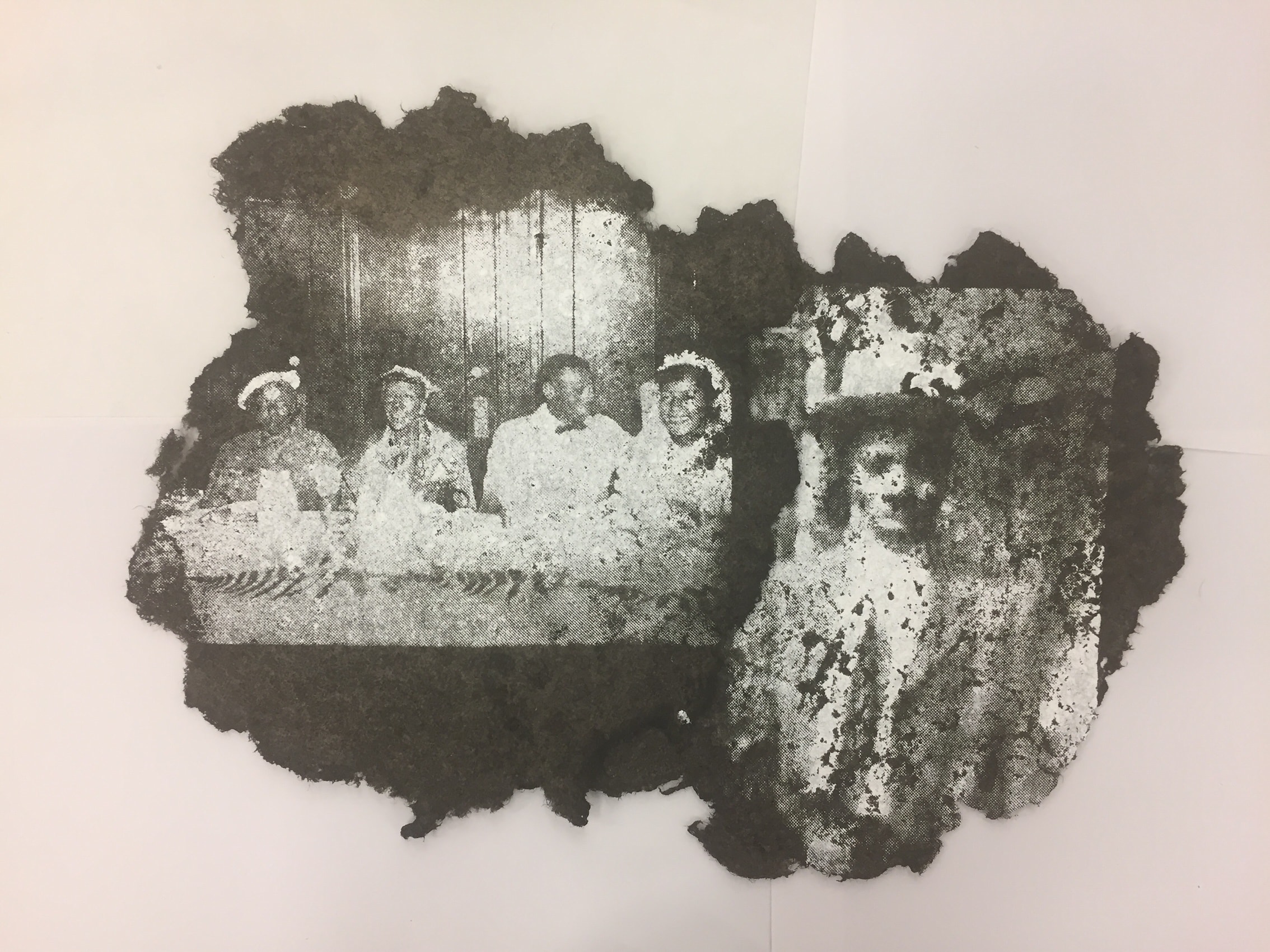
Adebunmi Gbadebo, And Don’t you Forget it, 2015, silkscreen on human hair, Collection of Minnesota Museum of Fine Arts. © Adebunmi Gbadebo
And how did you make these first sheets that were made from hair?
I basically put black hair in a blender, almost like making a hair smoothie, breaking up the strands of hair, and I added different adhesives to bind the hair together and then pour that pulp and dry it flat. I would then silkscreen images of my own ancestors on those sheets. I called that a double portrait, a kind of representational and abstract portrait. And, like I said, it naturally evolved to embed other materials. And even right now, I'm using paper making as I'm making two edition prints at two print shops, so my exploration of paper making has evolved even further.
This is such a great exploration and redefinition of the boundaries between material, surface and ground. Besides the archives you’re investigating and your family’s ancestry, are there artists, artworks, or even non artistic influences that have inspired or shaped your practice?
It's funny. Every time I'm asked this question, my mind goes blank. But who comes to mind immediately is the enslaved potter Dave Drake, and the way he claimed his humanity, asserted his personhood.
I think one of my favorite artists of all time is Jack Whitten. The way he pushed material, the way he redefined how to make a painting, the way he redefined the potential of acrylic paint. And even his work in sculpture. He could move across disciplines, and I say that also knowing that he wa sable to transform his paintings into sculptures. His paintings were built. He had a kind of foresight that led to creating his own archive, with the publication of Notes from the Woodshed, where he documented across decades, his studio practice and life. I think that really inspired me to think about the ways in which I will leave or in which I am archiving my own practice. Every dig I do when I'm collecting soil from True Blue Plantation is archived in jars and dated. Every envelope that I've received with hair donations of people who've mailed their hair has been documented and made into books. Every message or DM I get has been printed and archived.
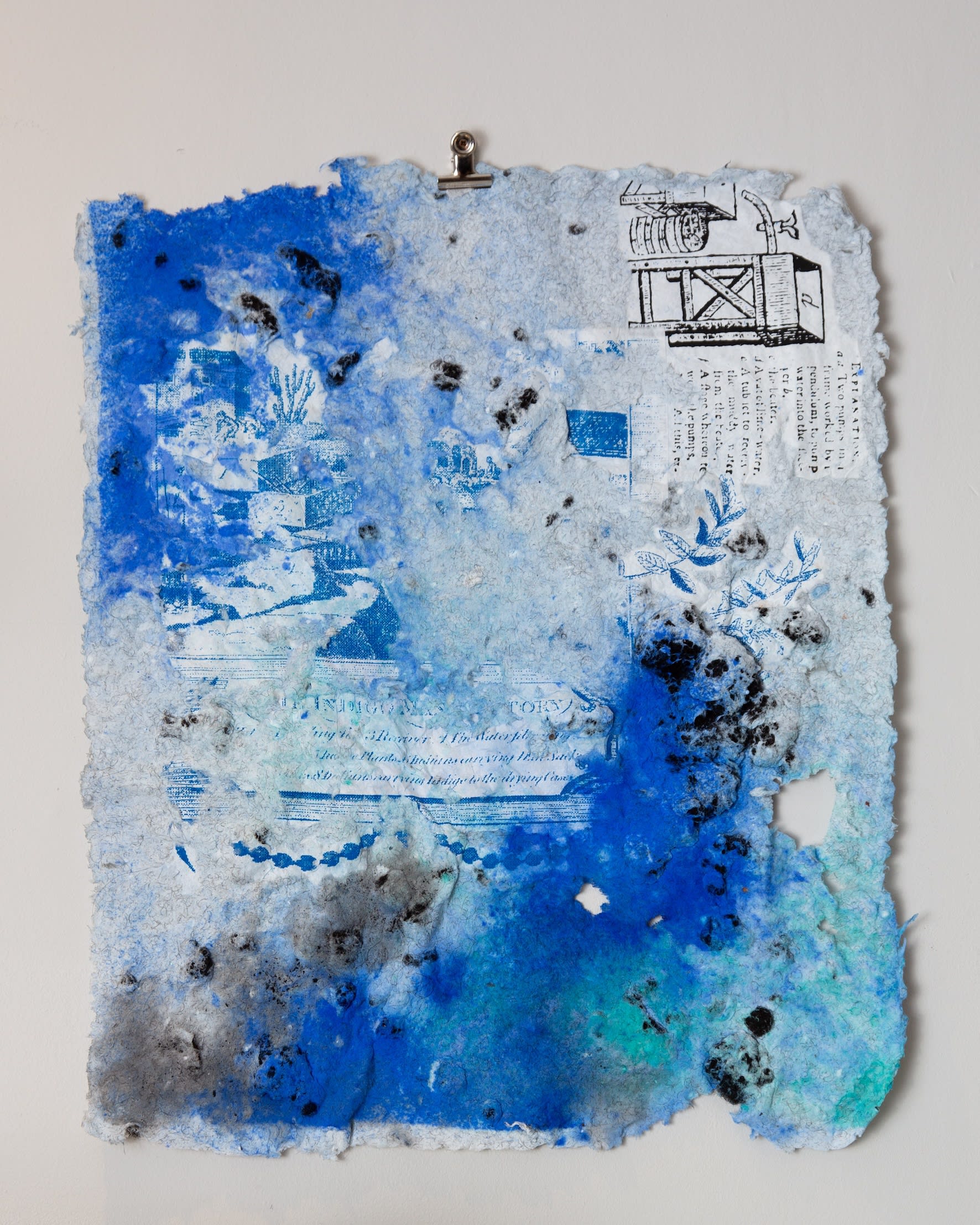 Adebunmi Gbadebo, Untitled 5, 2023, Black hair, cotton, rice paper, indigo dye and printed photographs, 55.9 x 43.2 cm.
Adebunmi Gbadebo, Untitled 5, 2023, Black hair, cotton, rice paper, indigo dye and printed photographs, 55.9 x 43.2 cm.
That’s fascinating, how everything’s intertwined, and how it becomes a network of lots of small connective undercurrents. How do new projects come to life? Is it rather the engagement with a material that acts as a starting point, or is the beginning more content driven, adding material choices later on?
I can't do anything twice. I have engaged in a practice of paper making and ceramics. But I have never made the same sheet twice compositionally, I have never given the same form to my vessels twice. I just really don't have the patience to make something over and over. So naturally, I'm always evolving. Currently, I'm working on a short film, so that's a new medium for me.
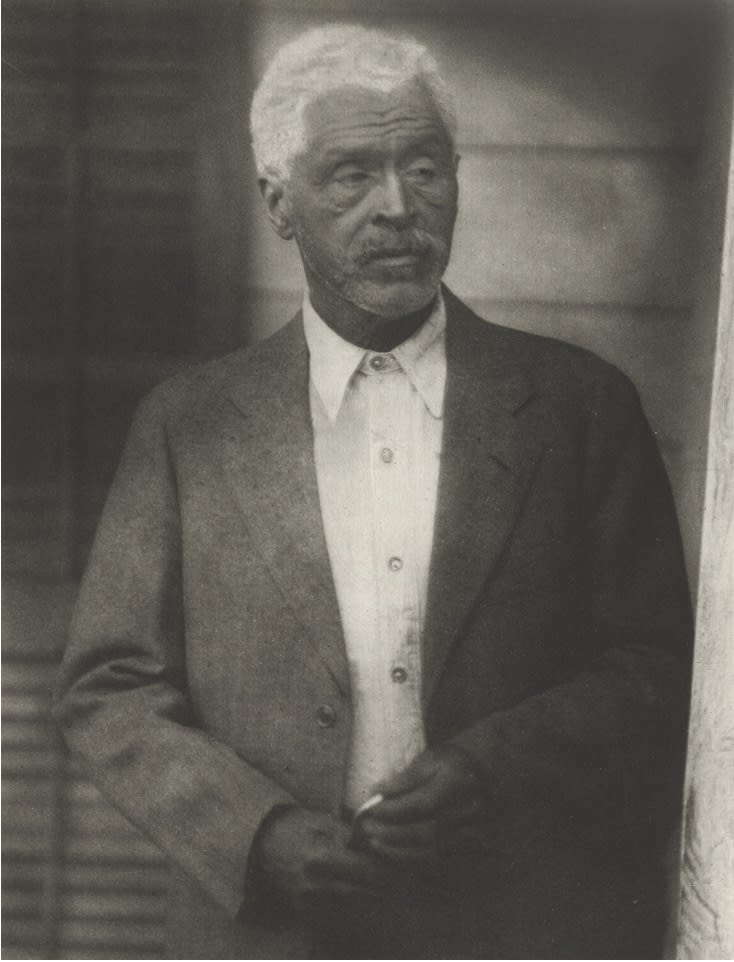
Photograph of the artist’s cousin Ellis Sanders taken by photographer Doris Ulmann, shown as part of Documenting Rural American Life, 2022, Museum of Modern Art, New York.
This already brings us to the last question: Looking ahead, are there new materials, themes or mediums you're interested in exploring in your future projects?
Definitely, I'll mention two, otherwise this could get long winded: The editions that I'm doing at High Point and Brandywine. The one that I'm doing at High Point print shop in Minneapolis is the result of a residency. I wanted to do a print of a flower. One that felt very sweet and simplistic yet was tied to my work. Through research, I learned that the flower periwinkle often grows where bodies are decomposing underground. There's a way in which that flower eats off the acidity of the soil that is created through decomposition. The print I'm doing at High Point was made by cutting out and overlaying the silhouettes of periwinkle on top of layers of landscape photos of True Blue cemetery. The flower becomes a marker of what we can't see, the marker of a body, of spaces where bodies may have been lost. I like the idea that this flower reveals the unknown or forgotten.
Through conversation with family, I found out that Julia Peterkin, who was one of the owners of Lang Syne Plantation, which neighbors True Blue and which family of mine was enslaved on also, became a major author. This, I wanted to incorporate into the second print I am doing, the one at Brandy Wine. One of her books, ‘Scarlet Sister Mary’, won her a Pulitzer Prize for being one of the first books in US-American literature to depict Southern Black people in a positive light. Of course, reading this book now, her writings are very problematic. But the characters in the book that won her a Pulitzer Prize were my ancestors. And furthermore, another book she wrote, ‘Roll, Jordan, Roll’ also used my ancestors as subjects. She enlisted the famous photographer Doris Ullmann to photograph my ancestors on True Blue Plantation. Those images of my ancestors were recently included in a show at the Museum of Modern Art in 2002. Unfortunately, they were all listed as unknown. The descendants of the people in Doris’ images do know who the depicted are – their great grandfather, great grandmother or grandmother. So, the print that I’m doing at Brandy Wine is deconstructing Doris’ images and reconstructing them within their direct descendance. Also grappling with the idea of the fact that my ancestors were trapped within these books and photographs of white people who have literally built their careers off the exploitation of my family and continue to do so. in numerous ways. Literary careers, photographic careers by taking their images and stories.
It's devastating but there’s a way in which my family has been able to recover a lot of information because they’re not just in these plantation archives, their lives have been documented through these images. I may not have known what any of these relatives looked like without Doris’ photographs. It’s a weird dichotomy.
Interview conducted by Maren Möhlenkamp